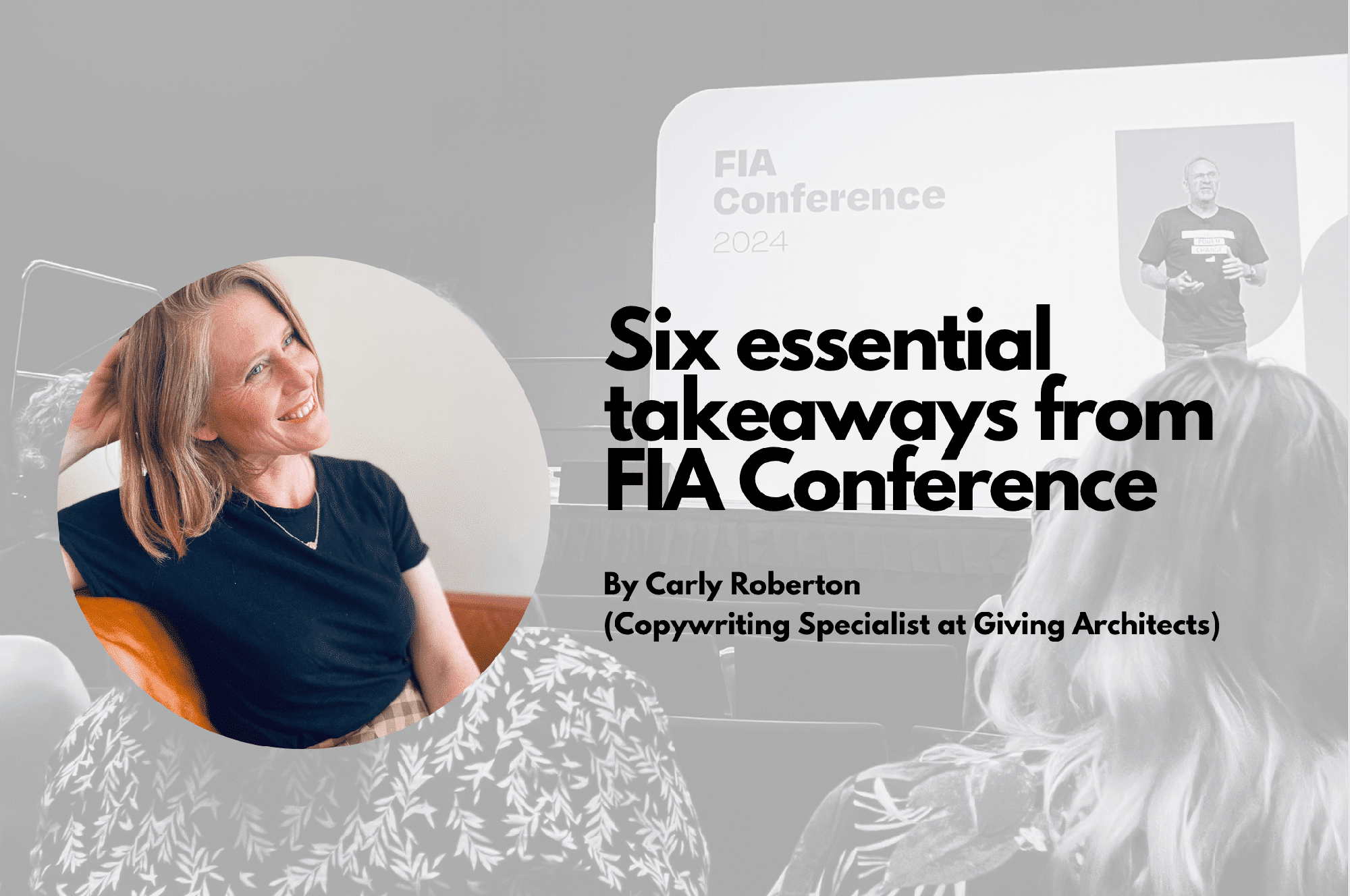Six essential takeaways from FIA Conference 2024

Last month, together with the rest of the Giving Architects New Zealand team, I crossed the Tasman to join our Australian colleagues at the Fundraising Institute Australia’s (FIA) annual conference. It was the biggest yet, with more than 1300 delegates and 30 speakers from all over the globe.
The theme of the conference was ‘where passion meets purpose’. And boy, did I meet some passionate fundraisers! There was a palpable willingness to do better and be better – all to create a better world.
I attended a range of sessions to challenge and feed my craft. There were many learnings, but six essential takeaways stood out. These insights are not only for fellow copywriters but for all fundraisers – no matter where you are on your journey. Enjoy!
Fundraising is a long game
I want to begin with perhaps the most important takeaway, something we often lose sight of as fundraisers. That is, fundraising is a long game.
It’s a known fact that 80% of your income comes from 20% of your donors. From the very first touch point, you must steward your donors in the hope that they will eventually become one of the 20%.
Fundraising is a two-way relationship, which includes listening to and learning from your donors. Key to effective stewardship is also thanking as often as possible. We focus so much on getting the ask right, it’s easy to overlook this vital step. But when you have the long game in mind, thanking is just as important as the ask.
DM + digital delivers results
We live in a digital world and the importance of fundraising in this space cannot be ignored. But the reality is that direct mail still gets results and should still be a vital part of your fundraising mix.
A few stats that were presented in a session on DM worldwide trends proved this point. Direct mail has 75% brand recall versus 44% for digital and direct mail motivation response is 20% higher than digital. However, the key to ground-breaking results is a combination of both. In fact, campaigns that use both DM and at least one digital element had a 118% increase in response rate.
It was emphasised that what works for DM doesn’t always work for digital, though. DM is typically lengthy, but digital fundraising should be the opposite (especially for social media). It’s important to not over explain, and to be impactful but succinct – think powerful images and (short!) videos that grab attention.
Branding and fundraising go hand in hand
During the popular myth smashers session, a fundraiser with a branding background successfully smashed the myth that branding is the enemy of fundraising. Branding is about building trust, and trust in your cause is paramount. Or else, why would people give?
So, being clear on your values, your positioning, your purpose, and how your donors perceive your organisation is key. And then ask yourself how you can communicate your brand to your audience in a consistent and creative way. Fundraising and branding don’t need to compete, they can work together. And when they do, that’s when the magic happens.
What’s real will outperform polished every time
In saying the above, it was Camp Quality’s Head of Philanthropy, Hazel Grunwaldt, who made the point that what’s real will outperform polished every time. Consistent branding is important, she said, but to truly create impact you must demonstrate need in an authentic way.
Hazel led the award-winning (and result-smashing) Camp Quality appeal, “Childhood Not Cancerhood”. Their appeal letter incorporated (very cute) hand drawn unicorns illustrated by the hero of the story, and the digital elements of the campaign featured real photos of the little girl in hospital.
The finished result wasn’t necessarily professional or polished (and their designer hit the roof!) but it worked. And you could argue, that fun illustrations DID reflect their brand. Camp Quality is all about fun! This is a perfect example of branding and fundraising working together to create magic.
Lean into your core
Another key takeaway from Hazel was the importance of leaning into the core of your cause. As a fundraising copywriter, distilling messages can be challenging. But by focusing on your essence – the unmet need and who you are serving – everything should flow from there.
That’s why, your internal case for support is so important. I was reminded of their value during a session with Ellaine Hislop, Head of Fundraising at Perth Zoo. She swears by a solid case for support as the foundation of any successful fundraising programme. Whether it’s for your organisation as a whole or for a capital campaign, these crucial but often overlooked documents sum up your purpose and clarify your messages.
Perfect is the enemy of good
And to finish, a reminder of the perils of perfectionism. Learning from failure was a common theme throughout the conference, but when one seasoned fundraiser quoted Voltaire, the message really hit home.
The quote was “perfect is the enemy of good”, but she added the twist that perfect is also the enemy of done. If we’re striving to be perfect in fundraising (impossible, right?), then quite simply, we won’t achieve anything.
The antidote to perfectionism is to celebrate failure as much as success. Failure provides valuable insights into how we can do better and be better. That’s why testing is so important. So, where and when you can, test your messages, test your asks, test your tactics. And when something doesn’t work, ask yourself, why?
Speaking of perfectionism, I’m going to stop editing (and re-editing!) this blog and hit publish!
